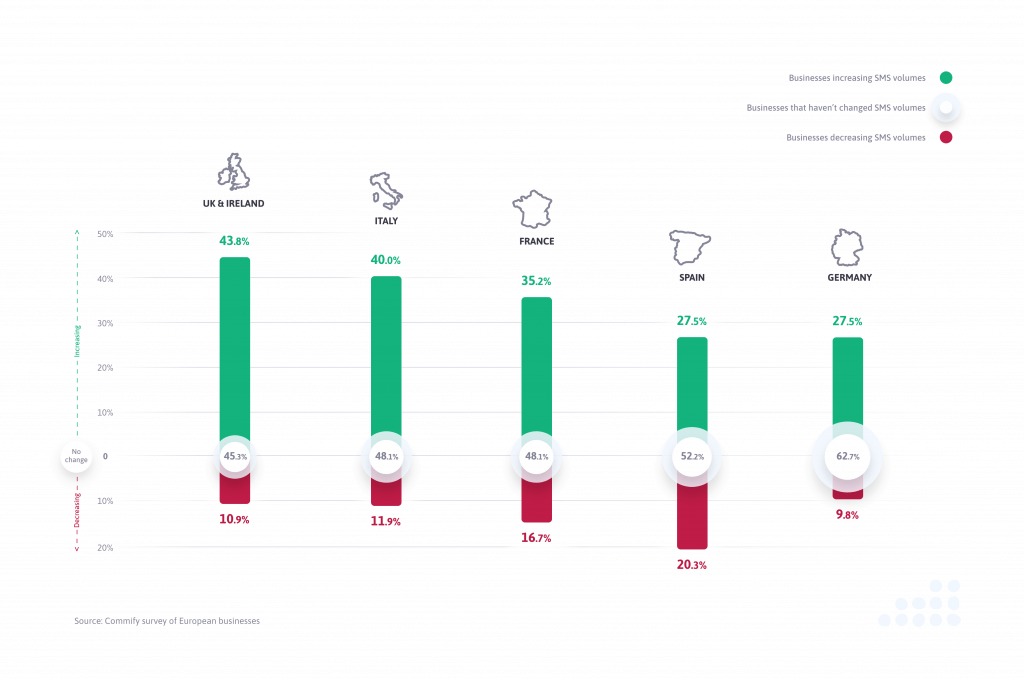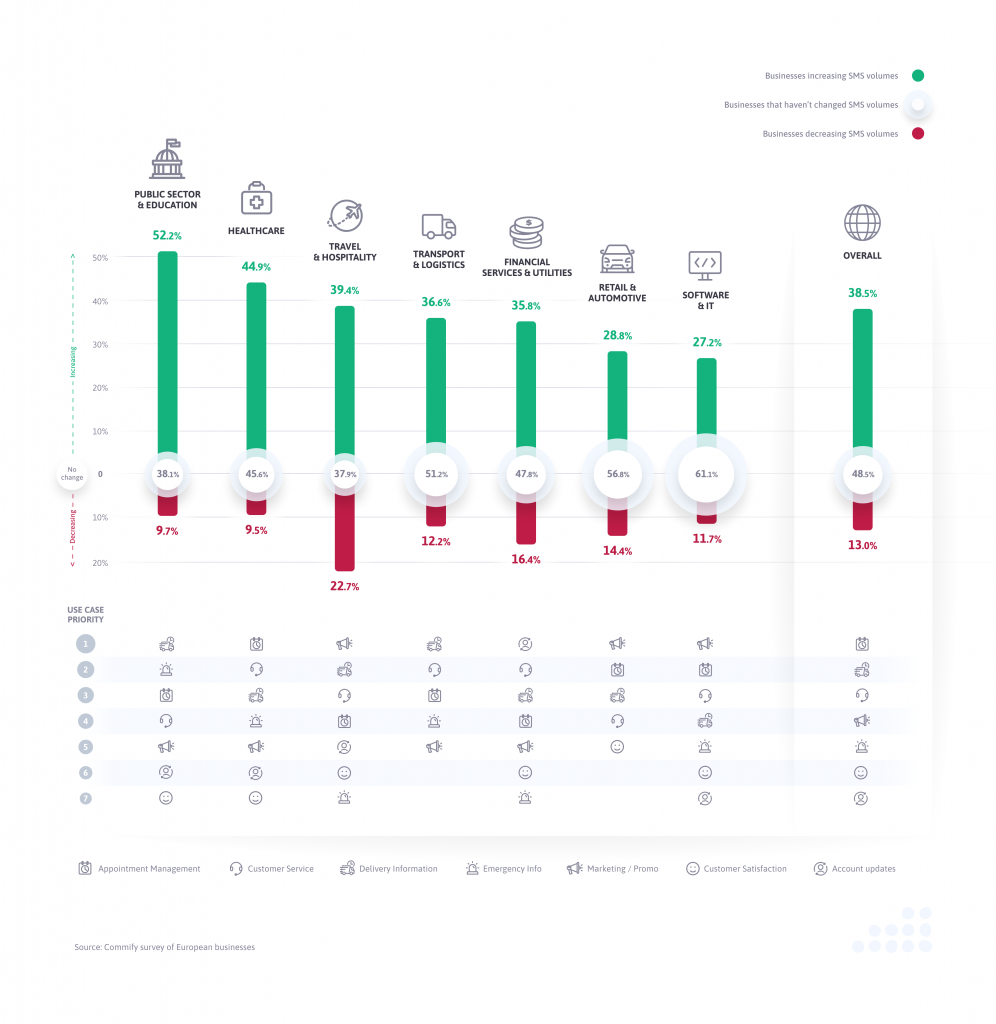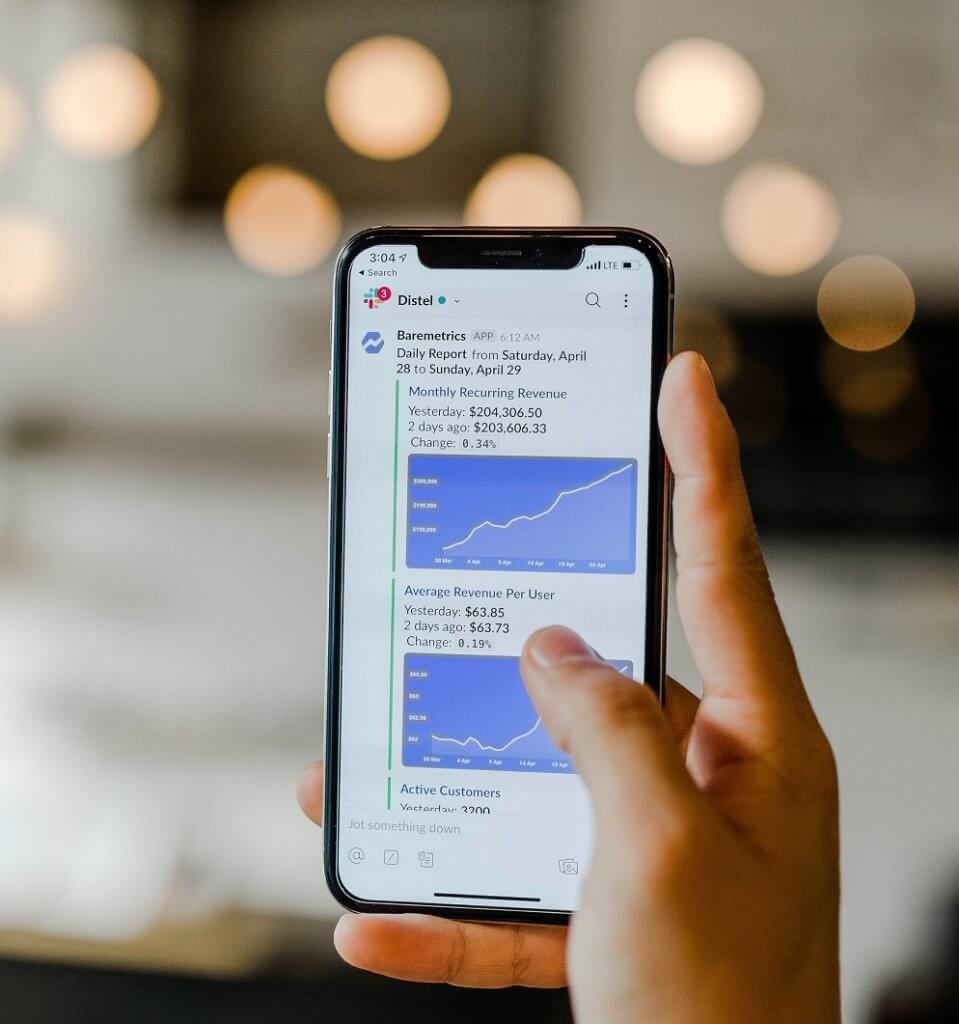The financial impact of the coronavirus is undeniable and continues to develop as we enter new stages of the pandemic. The spread of Covid-19 has left businesses across the globe closely monitoring their increasing costs and planning for a recovery period.
Despite considerable efforts, many countries around the world are predicted to be entering recession, with the IMF stating that the global economy will shrink by 3% this year – a decline described as the worst since the Great Depression of the 1930’s.
In a bid to understand what companies and organisations across 5 different territories and 7 industries are doing to stay afloat, we surveyed over 650 international businesses, to determine how Covid-19 had affected their business messaging habits.
Overall, our data showed that 38% of companies were sending more business messages when compared to pre-pandemic levels and 13% confirmed volumes had reduced. What’s more, the two most common use cases for business messaging during Covid-19 were appointment reminders and delivery information. However interestingly, there were relatively large disparities between different territories.
Impact of Covid-19 on business messaging across territories

As can be seen in the chart above, businesses located in the UK and Ireland were the most likely to have increased business communication volumes during the pandemic (43.8%), with 45.3% stating there had been no change and just 10.9% reporting an overall decrease.
On the other hand, our research reveals that companies in Spain and Germany were most likely to be taking a more conservative approach to business messaging during the pandemic, with just 27.5% confirming a volume increase.
Additionally Spain represented the country whose businesses were most most likely to have reduced their business messaging (20.3%), and interestingly, recipients in Germany were the least likely to have reduced messaging throughout the pandemic, at just 9.8%.
The detail of this increase, split by business activity, can be found below:
- Delivery information – 20.56%
- Appointment management – 20.56%
- Marketing / promotional activity – 16.67%
- Customer service / process updates – 16.67%
- Emergency information – 11.94%
- Customer satisfaction surveys – 6.94%
- Account updates – 6.97%
Impact of Covid-19 on business messaging across industries

NB: For the percentage detail of use cases in relation to business messaging across each industry, please scroll to the last section of this post.
The industry analysis showed that in addition to business messaging increases between 27.2% and 52.2%, the most common areas for increased messaging was delivery information and marketing and promotion.
As you might expect, businesses in the travel and hospitality industries were the most likely to have decreased business messaging during the pandemic (22.7%), however 39.4% of these reported an overall increase in business messaging volumes when compared to pre-Covid19 times.
Moreover, organisations in the public sector & education, and healthcare were both most likely to have increased message volumes at 52.2% and 44.9% respectively; and least likely to have reduced communication volumes during the pandemic at 9.7% and 9.5%.
Predictions for business messaging trends in 2021
It’s clear from our research that many companies are using business messaging to continue driving interactions with consumers and engagement with existing customers. With this in mind, we have outlined three trends we predict will gain momentum into 2021 and form an important role in business recovery.
Business messaging will continue to rise
With face to face interactions reduced for the foreseeable future, brands across all industries are going to have to work harder to engage with existing and potential customers. But with all industries likely to increase their communications in one form or another, it is going to become harder for brands to cut through the noise. With that in mind, we predict that the use of channels such as SMS and WhatsApp will play a much larger role in communication strategies moving forward. Afterall, SMS benefits from an open rate of 95% and 90% of all text messages are read within 3 minutes.
Prioritisation of customer data
Clearly for businesses to successfully engage with their audiences, they cannot simply increase the volume of communications. Even prior to the pandemic, 54% of consumers anticipated a personalised discount within just one day of providing their details to a retailer. Due to the various lockdown measures, many consumers haven’t been able to interact with businesses in person and thus have had to become more comfortable with sharing their personal data, in order to continue progressing applications and completing purchases. Given this shift, we predict that 2021 will be the year that businesses prioritise customer data, and use this to enhance their customer communications with increasingly sophisticated personalisations, and audience segmentation.
Proactive communication will become the norm
During the pandemic, UK call volumes have increased by 44%. In order to manage this influx, while also addressing the various operational challenges which have come as a result of lockdown restrictions and reduced staffing, many companies have implemented proactive messaging. By sending proactive messages to customers regarding account and application updates, businesses can reduce call centre volumes while enhancing the customer experience. We predict that companies who have not yet experimented with proactive messaging will, and those who have already introduced these and are likely already experiencing the benefits, will look to add further use cases to their messaging strategy for next year.
Clearly the situation around the coronavirus is still unfolding, but businesses who are able to effectively communicate, place themselves in the best position for recovery.
If you would like any help creating more effective communications for your business, simply get in touch with one of our expert team at [email protected].
Areas of business messaging which have increased during the pandemic within each industry
Public Sector & Education
- Delivery information – 20.78%
- Appointment management – 18.18%
- Emergency information – 18.18%
- Customer service / process updates – 15.58%
- Marketing / promotional activity – 11.69%
- Account updates – 9.09%
- Customer satisfaction surveys – 6.49%
Healthcare
- Appointment management – 28.83%
- Customer service / process updates – 17.12%
- Delivery information – 16.22%
- Emergency information – 15.32%
- Marketing / promotional activity – 9.91%
- Account updates – 6.31%
- Customer satisfaction surveys – 6.31%
Travel & Hospitality
- Marketing / promotional activity – 34.38%
- Delivery information – 21.88%
- Customer service / process updates – 15.63%
- Appointment management – 9.38%
- Account updates – 6.25%
- Customer satisfaction surveys – 6.25%
- Emergency information – 6.25%
Transport & Logistics
- Delivery information – 45.45%
- Customer service / process updates – 18.18%
- Appointment management – 13.64%
- Emergency information – 13.64%
- Marketing / promotional activity – 9.09%
Retail & Automotive
- Marketing/promotional activity – 30.23%
- Appointment management – 23.26%
- Delivery information – 23.26%
- Customer service/process updates – 16.28%
- Customer satisfaction surveys – 6.98%
Finance and Utilities
- Account updates – 17.95%
- Customer service/process updates – 17.95%
- Delivery information – 17.95%
- Appointment management – 15.38%
- Marketing/promotional activity – 12.28%
- Customer satisfaction surveys – 10.26%
- Emergency information – 7.69%
Software & IT
- Marketing / promotional activity – 25.71%
- Appointment management – 17.14%
- Customer service / process updates – 17.14%
- Delivery information – 17.14%
- Emergency information – 11.43%
- Customer satisfaction surveys – 8.57%
- Account updates – 2.86%


